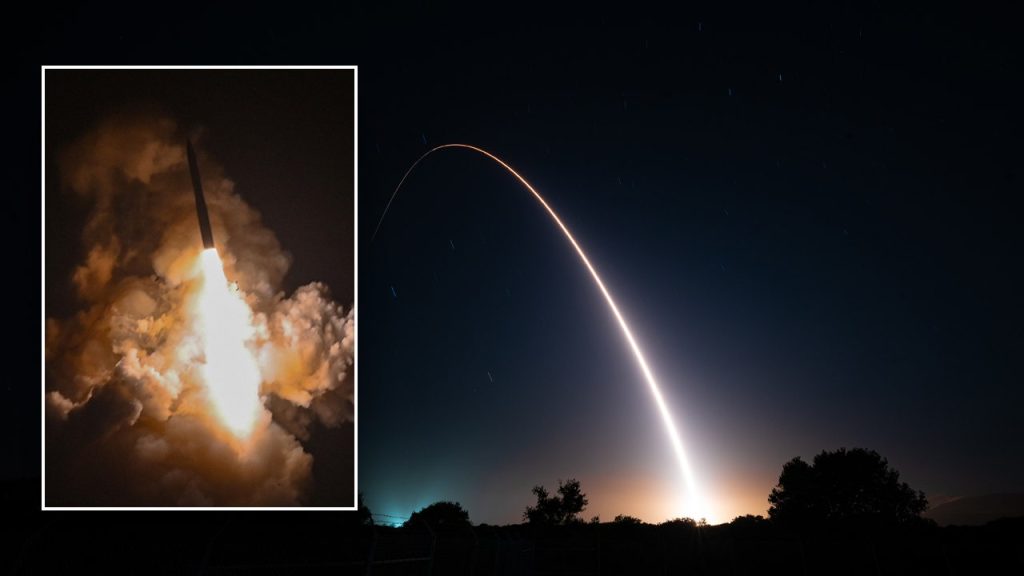The U.S. Air Force successfully executed a routine test of an unarmed intercontinental ballistic missile (ICBM) early Wednesday morning. The LGM-30G Minuteman III missile, launched from Vandenberg Space Force Base in California at 12:01 a.m. Pacific Time, is a crucial component of the nation’s nuclear deterrent strategy. This test underscores America’s commitment to maintaining a secure and reliable defense posture amid ongoing global tensions.
| Article Subheadings |
|---|
| 1) Overview of the Minuteman III Test Launch |
| 2) Significance of the Test |
| 3) Technical Capabilities of the Minuteman III |
| 4) Historical Context of the Minuteman System |
| 5) Future of the U.S. ICBM Program |
Overview of the Minuteman III Test Launch
On May 21, 2025, at precisely 12:01 a.m. Pacific Time, the U.S. Air Force launched an unarmed LGM-30G Minuteman III intercontinental ballistic missile from the Vandenberg Space Force Base in California. This launch marked a routine test, essential for assessing the missile’s operational capability. The missile traveled at speeds approaching 15,000 mph and made its way to a predetermined test range near the Kwajalein Atoll in the Marshall Islands, approximately 4,200 miles from its launch site. The Air Force confirmed that this exercise was planned and was not a reaction to current global situations.
Significance of the Test
The primary purpose of the ICBM test launch was to reinforce the strength of the United States nuclear deterrent, as stated by Gen. Thomas Bussiere, commander of Air Force Global Strike Command. In his remarks, Gen. Bussiere emphasized that the missile test serves as a significant reminder of the readiness of America’s nuclear arsenal. “This test launch underscores the strength of the nation’s nuclear deterrent and the readiness of the ICBM leg of the triad,” he asserted, underscoring that the successful execution of such tests is vital for maintaining national security. Notably, the military conducted over 300 similar tests in the prior decades, demonstrating their commitment to maintaining a robust deterrence posture.
Technical Capabilities of the Minuteman III
The LGM-30G Minuteman III represents one of the most advanced ICBMs in service today, capable of being armed with a nuclear payload. It is equipped with a sophisticated Mark-21 High Fidelity Re-Entry Vehicle, which enhances its targeting precision and effectiveness. The missile’s ability to reach speeds of 15,000 mph upon re-entry exemplifies the technological advancements in missile design that have taken place since its inception. Each Minuteman III missile can carry multiple warheads, making it a significant component of the U.S. nuclear triad, which includes land-based ICBMs, submarine-launched ballistic missiles, and nuclear-capable strategic bombers.
Historical Context of the Minuteman System
The Minuteman weapon system has been a cornerstone of the United States’ strategic defense since it first became operational in the early 1970s. Over the years, it has undergone numerous enhancements, improving its reliability and effectiveness in deterring potential adversaries. As a part of the Cold War strategy, the Minuteman system was designed to ensure a credible second-strike capability, thus preventing adversaries from launching a first strike against the U.S. or its allies. The enduring presence of Minuteman IIIs in the U.S. arsenal has allowed for the deterrent strategy to adapt alongside evolving geopolitical landscapes.
Future of the U.S. ICBM Program
As part of a modernization effort, the U.S. Air Force is planning to replace the aging Minuteman III missiles with a new system named Sentinel. Designed to incorporate modern technology and address the challenges of the 21st century, Sentinel will enhance the overall effectiveness and safety of the U.S. nuclear deterrent. This upcoming transition reflects the military’s commitment to ensuring that its capabilities remain relevant in a rapidly changing global environment while maintaining strategic stability and assurance for U.S. allies.
| No. | Key Points |
|---|---|
| 1 | The U.S. Air Force launched an unarmed Minuteman III ICBM from Vandenberg Space Force Base. |
| 2 | The missile traveled at speeds of 15,000 mph to its test range in the Marshall Islands. |
| 3 | The test was routine and not a reaction to current world tensions, with over 300 similar tests conducted previously. |
| 4 | Minuteman III missiles have been part of U.S. strategic defense since the early 1970s. |
| 5 | The U.S. is transitioning to a new modern ICBM system named Sentinel as part of ongoing upgrades. |
Summary
The recent launch of the LGM-30G Minuteman III ICBM serves as a critical component of the United States’ defense strategy, showcasing the military’s commitment to maintaining an effective and reliable nuclear deterrent. As global threats evolve, these routine tests ensure that the nation’s security apparatus remains robust and ready to address potential challenges. With future plans to transition to the Sentinel system, the Air Force is poised to enhance its capabilities to meet the demands of contemporary security environments.
Frequently Asked Questions
Question: What is an ICBM?
An Intercontinental Ballistic Missile (ICBM) is a long-range missile designed to deliver a nuclear warhead to a target over distances greater than 5,500 kilometers (about 3,400 miles).
Question: Why are tests like this conducted?
Tests are conducted to ensure the reliability, safety, and effectiveness of the nuclear deterrent system and to demonstrate the country’s readiness to respond to any potential threats.
Question: What is the nuclear triad?
The nuclear triad refers to the three systems used by the U.S. military to deliver nuclear weapons: land-based ICBMs, submarine-launched ballistic missiles, and nuclear-capable strategic bombers, which provide a robust deterrent against adversaries.


